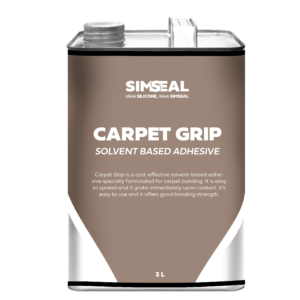How to seal internal joints using silicone sealants?
Have you got a leaking sink or bath you need to waterproof?
Joint sealing creates a waterproof seal to intercept movement within the surfaces or at the point of intersection between various building elements.
Joint sealants are used for several purposes including: –
- to close open joints to keep water and air out (both exterior and interior)
- for appearance and cleanability (in interior surfaces where water resistance is not an issue)
- and to reduce sound transmission through cracks (usually interior and internal to composite assemblies).
Silicone sealant is a great way to fill in gaps between tiles, shower screens, baths, and sinks. It also stops water from seeping in where you don’t want it.
Here’s how you can apply silicone sealant to your project
Caution
When working with cement-based products, always wear eye protection and waterproof gloves.
Step 1: Prep the area
To give the silicone the best bonding surface possible, clean and dry all your surfaces before you start. Ensure that any dirt or loose debris is removed.
Step 2: Gather your materials
You’ll need paddle pop sticks, Simseal SS100 100% Premium Neutral Cure Sanitary Sealant, a silicone gun, a spray bottle, and a knife
Step 3
Using a utility knife, cut the tip of the nozzle at an angle, and insert the tube into a standard caulk gun. Make sure to match the cut to the width of the crack.


Step 4
Use the caulking gun to apply silicone to the gap, working smoothly and evenly. Don’t worry if it looks a bit rough, you can fix that in the next step
Step 5: Finish by wiping off the excess silicone
Use a damp rag over the tip of your finger to wipe along the newly sealed gap. This will wipe off any excess and push sealant further into the gap to help give you a neat finish

Step 6
For tight corners, use a chisel to neaten the edge.
Step 7
Clean off any excess with the rag.
Shopping List
- Simseal Glaze 100 300ml
https://simseal.com.au/product/clear-silicone-sealant-professional-grade-case-of-12/
Recommended for sealing concrete joints like precast wall panel joints, expansion joints, control joints, connection joints, etc. It is also ideal for window frame perimeter sealing especially when the sealant needs to be painted. Other recommended applications include sealing of GRC panel systems, anodized aluminum, masonry, porcelain, coated metal, finished wood, epoxy and polyester panels, UPVC, polystyrene, and stainless steel.
- Simseal SS100 100% Premium Neutral Cure Sanitary Sealant
https://simseal.com.au/product/ss100-100-neutral-cure-sanitary-sealant-300ml/
SS100 100% Neutral Sanitary Sealant has excellent adhesion to glass, ceramics, aluminum, masonry, stone, concrete, most metals, and many plastics. It may be used for general glazing and weatherproofing applications including wet areas and humid environments. It resists mildew when exposed to prolonged hot and humid environments and is suitable for sealing in kitchens, vanities, bathrooms, shower screens, and any other wet area applications.
- SIMSEAL Backer Rod (for joints over ¼ inch)
- Standard Caulk Gun
- Utility Knife
- Stiff Bristle Brush
- Commercial Solvent or Citrus-Based Cleaner
Do you require bulk purchases including custom printing your logo on silicone sealant products? Email us at info@simseal.com.au
Need expert advice on selecting the right silicone sealant products? Contract Simseal by clicking here

Comments
Post a Comment